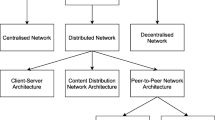Abstract
Video-on-demand service in wireless networks is one important step to achieving the goal of providing video services anywhere anytime. Typically, carrier mobile networks are used to deliver videos wirelessly. Since every video stream comes from the base station, regardless of what bandwidth sharing techniques are being utilized, the media stream system is still limited by the network capacity of the base station. The key to overcome the scalability issue is to exploit resources available at mobile clients in a peer-to-peer setting. We observe that it is common to have a carrier mobile network and a mobile peer-to-peer network co-exist in a wireless environment. A feature of such hybrid environment is that the former offers high availability assurance, while the latter presents an opportunistic use of resources available at mobile clients. Our proposed video-on-demand technique, PatchPeer, leverages this network characteristic to allow the video-on-demand system scale beyond the bandwidth capacity of the server. Mobile clients in PatchPeer are no longer passive receivers, but also active senders of video streams to other mobile clients. Our extensive performance study shows that PatchPeer can accept more clients than the current state-of-the-art technique, while maintaining the same Quality-of-Service to clients.




















Similar content being viewed by others
Notes
User, node, client, and peer are used interchangeably in this paper.
References
Advanced traveler information system capabilities: human factors research needs. http://www.fhwa.dot.gov/tfhrc/safety/pubs/98-186.pdf
Biedl TC, Demaine ED, Golynski A, Horton JD, López-Ortiz A, Poirier G, Quimper CG (2003) Optimal dynamic video-on-demand using adaptive broadcasting. In: ESA, pp 90–101
Cai Y, Hua KA (2003) Sharing multicast videos using patching streams. Multimedia Tools and Appl 22(2):125–146
Cavalcanti D, Agrawal D, Cordeiro C, Xie B, Kumar A (2005) Issues in integrating cellular networks wlans, and manets: a futuristic heterogeneous wireless network. IEEE Wirel Commun 12:30–41
Dai H, Chan E (2008) Quick patching: an overlay multicast scheme for supporting video on demand in wireless networks. Multimedia Tools Appl 36(3):221–242. doi:10.1007/s11042-007-0143-6
De P, Sharma S, Shuvalov A, Chiueh T (2004) Wivision: a wireless video system for real-time distribution and on-demand playback. In: Proceedings of the IEEE consumer communications and networking conference (CCNC)
Guo M, Ammar MH, Zegura EW (2005) V3: a vehicle-to-vehicle live video streaming architecture. In: PerCom, pp 171–180
Hauge M, Hafslund A, Li F, Kure O (2004) Multicast-service distribution on a cellular network assisted by local ad hoc networks. In: Med-Hoc-Net, pp 68–80
Hauge M, Kure I (2007) A heterogeneous multihop wireless access network for multipoint streaming: a detailed performance analysis. IPSJ Digital Courier 3:332–342
Hauge M, Kure O (2004) Multicast service availability in a hybrid 3g-cellular and ad hoc network. In: International workshop on wireless ad-hoc networks, pp 135–139
He Y, Lee I, Gu X, Guan L (2005) Centralized peer-to-peer video streaming over hybrid wireless network. In: ICME, pp 550–553
Henden L. (ed) (2005) Broadcast and multicast—a vision on their role in future broadband access networks. http://cordis.europa.eu/ist/ct/proclu/c/broadcast.htm
Hua KA, Tantaoui MA, Tavanapong W (2004) Video delivery technologies for large-scale deployment of multimedia applications. Proc IEEE 92(9):1439–1451
Hung RYS, Ting HF (2007) An optimal broadcasting protocol for mobile video-on-demand. In: Conf in research and practice in information technology (CRPIT), pp 79–84
Imielinski T, Viswanathan S, Badrinath B (1997) Data on air: organization and access. IEEE Trans Knowl Data Eng 9(3):353–372
Kashyap A, Ganguly S, Das SR, Banerjee S (May 2007) Voip on wireless meshes: models, algorithms and evaluation. In: INFOCOM 2007. 26th IEEE international conference on computer communications. IEEE, pp 2036–2044 doi:10.1109/INFCOM.2007.236
Lao L, Cui JH (2006) Reducing multicast traffic load for cellular networks using ad hoc networks. IEEE Trans Veh Technol 55(3):822–830
Luo H, Ramjee R, Sinha P, Li LE, Lu S (2003) Cellular and hybrid networks: Ucan: a unified cellular and ad-hoc network architecture. In: ACM MobiCom
Park JC, Kasera S (2005) Enhancing cellular multicast performance using ad hoc networks. In: IEEE conference on wireless communications and networking (WCNC), pp 2175–2181
Sato K, Katsumoto M, Miki T (2006) P2mvod: peer-to-peer mobile video on-demand. In: Proc 8th int conf on advanced communication technology (ICACT), pp 1986–1870
Shah SH, Chen K, Nahrstedt K (2005) Dynamic bandwidth management in single-hop ad hoc wireless networks. Mob Netw Appl 10(1–2):199–217. doi:10.1145/1046430.1046445
Tran DA, Le M, Hua KA (2004) Mobivod: a video-on-demand system design for mobile ad hoc networks. In: Mobile data management, pp 212–223
Wei H (2004) Integrating mobile ad hoc networks with cellular networks. Ph.D. thesis, Department of Electrical Engineering, Columbia University
Wei W (2006) Multipath unicast and multicast video communication over wireless ad hoc networks. Ph.D. thesis, Department of Electrical Engineering and Computer Sciences, University of California, Berkeley
Yang Y, Kravets R (2005) Contention-aware admission control for ad hoc networks. IEEE Trans Mob Comput 4(4):363–377. doi:10.1109/TMC.2005.52
Yeung MKH, Kwok YK (2008) Energy efficient media streaming in wireless hybrid peer-to-peer systems. In: IPDPS
Author information
Authors and Affiliations
Corresponding author
Rights and permissions
About this article
Cite this article
Do, T.T., Hua, K.A., Jiang, N. et al. PatchPeer: A scalable video-on-demand streaming system in hybrid wireless mobile peer-to-peer networks. Peer-to-Peer Netw. Appl. 2, 182–201 (2009). https://doi.org/10.1007/s12083-008-0027-1
Received:
Accepted:
Published:
Issue Date:
DOI: https://doi.org/10.1007/s12083-008-0027-1




